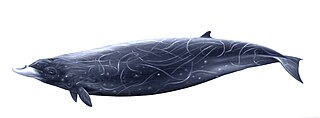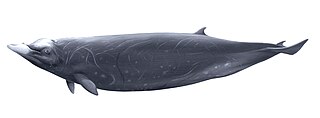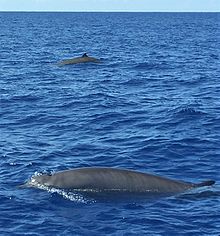
Andrews' beaked whale, sometimes known as the deep-crest beaked whale or splay-toothed whale, is one of the least known members of a poorly known genus. The species has never been observed in the wild, and is known only from specimens washed up on beaches.

Sowerby's beaked whale, also known as the North Atlantic or North Sea beaked whale, is a species of toothed whale. It was the first mesoplodont whale to be described. James Sowerby, an English naturalist and artist, first described the species in 1804 from a skull obtained from a male that had stranded in the Moray Firth, Scotland, in 1800. He named it bidens, which derives from the two teeth present in the jaw, now known to be a very common feature among the genus.

Hubbs' beaked whale was initially thought to be an Andrews' beaked whale when discovered by ichthyologist Carl Hubbs; however, it was named in his honor when it was discovered to be a new species. This species has the typical dentition found in the genus, but its main outstanding features are a white "cap" on the head and very extensive scarring. The species is known from 31 strandings, a few at-sea sightings, and observations of two stranded whales that were kept in captivity for 16–25 days.

Blainville's beaked whale, or the dense-beaked whale, is believed to be the widest ranging mesoplodont whale. The French zoologist Henri de Blainville first described the species in 1817 from a small piece of jaw — the heaviest bone he had ever come across — which resulted in the name densirostris. Off the northeastern Bahamas, the animals are particularly well documented, and a photo identification project started sometime after 2002.

The ginkgo-toothed beaked whale is a poorly known species of whale even for a beaked whale, and was named for the unusual shape of its dual teeth. It is a fairly typical-looking species, but is notable for the males not having any scarring.

Gray's beaked whale, sometimes known as Haast's beaked whale, the scamperdown whale, or the southern beaked whale, is one of the better-known members of the genus Mesoplodon. This species is fairly gregarious and strands relatively frequently for a beaked whale. In the Māori language, this species is called hakurā or iheihe.

The strap-toothed beaked whale, also known as Layard's beaked whale, is one of the largest members of the Mesoplodon genus, growing to 6.2 m (20 ft) in length and reaching up to 1,300 kg (2,900 lb). The common and scientific name was given in honor of Edgar Leopold Layard, the curator of the South African Museum, who prepared drawings of a skull and sent them to the British taxonomist John Edward Gray, who described the species in 1865.

True's beaked whale is a medium-sized whale in the genus Mesoplodon. It is native to the northern Atlantic Ocean. The common name is in reference to Frederick W. True, a curator at the United States National Museum.

The tropical bottlenose whale, also known as the Indo-Pacific beaked whale or Longman's beaked whale, was considered to be the world's rarest cetacean until recently, but the spade-toothed whale now holds that position. As of 2010, the species is now known from nearly a dozen strandings and over 65 sightings. This is the only species in the genus Indopacetus.

The pygmy beaked whale, also known as the bandolero beaked whale, Peruvian beaked whale and lesser beaked whale, is the smallest of the mesoplodonts and one of the newest discoveries. There were at least two dozen sightings of an unknown beaked whale named Mesoplodon sp. A before the initial classification, and those are now believed to be synonymous with the species. The species was formally described in 1991, based on ten specimens obtained from Peru between 1976 and 1989, including a 3.72 m (12.2 ft) adult male as the type specimen. A specimen that stranded at Paracas, Peru in 1955 has since been identified as a pygmy beaked whale. Since 1987, there have been an additional 40 sightings of the species, for a total of 65.

Stejneger's beaked whale, also known as the Bering Sea beaked whale or the saber-toothed whale, is a relatively unknown member of the genus Mesoplodon inhabiting the North Pacific Ocean. Leonhard Hess Stejneger collected the type specimen on Bering Island in 1883, from which Frederick W. True provided the species' description in 1885. In 1904, the first complete skull was collected, which confirmed the species' validity. The most noteworthy characteristic of the males is the very large, saber-like teeth, hence the name.

Cuvier's beaked whale, goose-beaked whale, or ziphius is the most widely distributed of all beaked whales in the family Ziphiidae. It is smaller than most baleen whales—and indeed the larger toothed cetaceans —yet it is large among the beaked whales and smaller cetaceans, appearing somewhat like a bigger and stockier bottlenose dolphin. Cuvier's beaked whale is pelagic, generally inhabiting waters deeper than 300 m (1,000 ft), though it has been observed closer to shore on occasion. In these offshore waters, Cuvier's beaked whale executes some of the deepest, longest recorded dives among whales, and extant mammals, at 2,992 m (9,816 ft), for 222 minutes. While likely diving to forage and hunt prey, such as cephalopods, and potentially evade predators, the frequency and exact reason for these extraordinary dives is unclear. Despite its deepwater habitat, it is one of the most frequently-spotted beaked whales when surfacing.

The northern bottlenose whale is a species of beaked whale in the ziphiid family, being one of two members of the genus Hyperoodon. The northern bottlenose whale was hunted heavily by Norway and Britain in the 19th and early 20th centuries. It is one of the deepest-diving mammals known, reaching depths of 2,339 m (7,674 ft) and capable of diving for up to 130 minutes.

The striped dolphin is a dolphin found in temperate and tropical waters of all the world's oceans. It is a member of the oceanic dolphin family, Delphinidae.

Perrin's beaked whale is part of the toothed whale suborder and is one of over 90 known cetaceans in existence today. Beaked whales are part of the family Ziphiidae, which are the second most diverse group out of all marine mammals with over 20 species currently recognized. Although diverse, little is understood about these timid, deep divers that can dive for up to two hours. The whales are partially named after their beak shaped jaw, which extends from their small head. The genus name Mesoplodon comes from the Greek meanings of meso- (middle), - hopla (arms), - odon (teeth), and may be translated as 'armed with a tooth in the center of the jaw'.

The Agreement on the Conservation of Cetaceans of the Black Sea, Mediterranean Sea and contiguous Atlantic Area, or ACCOBAMS, is a regional international treaty that binds its States Parties on the conservation of Cetacea in their territories. The Agreement aims is to reduce threats to Cetaceans in the Mediterranean and Black Seas, as well as in the contiguous Atlantic area west of the Straits of Gibraltar.
Deraniyagala's beaked whale is a species of mesoplodont whale closely related to the ginkgo-toothed beaked whale.
Cetaceans form an infra-order of marine mammals. In 2020, approximately 86 species of cetaceans had been identified worldwide. Among these species, at least 35 have been sighted in the wider Caribbean region with very widespread distribution and density variations between areas. Caribbean waters are a preferred breeding site for several species of mysticeti, who live further north the rest of the year. The tucuxi and the boto live at the southern periphery of the Caribbean region in the freshwaters of the Amazon River and surrounding drainage basins.

Natacha Aguilar de Soto is a Spanish marine biologist at the University of La Laguna (ULL), Tenerife, Canary Islands. She is a Ramón y Cajal research and teaching fellow at ULL and has been a Marie Skłodowska-Curie Research Fellow at ULL and at the Center for Research in Ecological Modeling (CREEM) of the University of St. Andrews (SMRU). She is the director of cetacean research within ULL's BIOECOMAC.
An unusual mortality event (UME) is a term in United States environmental law that refers to a set of strandings, morbidities, or mortalities of marine mammals that are significant, unexpected, and demanding of an immediate response. While the term is only officially defined in a statute in the US, it has been employed unofficially by cetacean conservation agencies and organizations internationally as well.























